topics
Straight Pins
Products
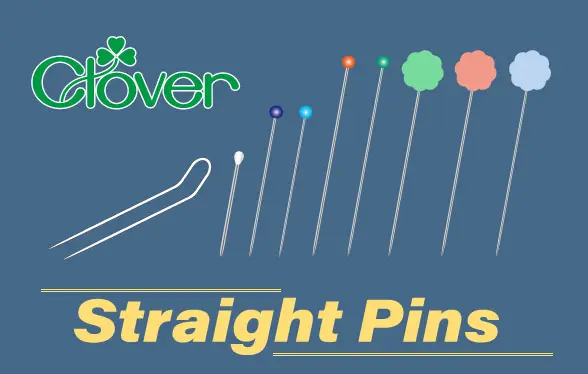
- What is it?
What do we think of when the topic of straight pins comes to the fore? Usually we think of those sharp little devils that find us when we’re not looking for them. You know, the one that’s hidden in that quilt top that we’re folding (but is now in our finger) or perhaps the one that we dropped earlier in the day and is now lodged in our favorite pair of socks (that we’re still wearing) or maybe the one we forget to remove and hit with our sewing machine needle (that breaks). And when we do find that pin cushion we’ve been looking for, we see it’s loaded with an almost indecipherable array of pin types and sizes (and the search continues). Yes, pins can be a “pain” but we really can’t do without them either. They’re necessary to almost everything we do in all genres of sewing. In fact they are just as elemental to what we do as scissors and needles and threads. And because of that importance we need to make sure we always use best style and size needle for each unique application. Here are a couple of things to keep in mind:
Size – As with sewing machine needles, we should always use the finest needle possible to be the least intrusive with our fine fabrics. If our pins are buckling as we insert them though, it’s probably a sign that we need to go to a heavier shaft. They shouldn’t bend. Length is important too. If we’re pinning several layers of fabric together as in quilting or pinning large seam allowances we’ll need to use longer pins. For appliqué, on the other hand, we can (and should) get away with shorter pins.
Pin heads – The pin heads are very important. That’s the handle that allows us to effectively manipulate the pins. We have tiny metal heads, plastic heads, glass heads, and flat heads. Each provides specific advantages so pick the one that best suits your needs. If you’re planning on ironing over your pins it’s a good idea to verify their heat resistance before using them.
Points – This is the business end of the pin. Needless to say it should be clean and sharp. The extra-sharp category also exists for special needs. Dull, bent or corroded (really old) needles damage our fabric and test our patience. When in doubt toss it. This is not the place to be stingy.
- What does it do?
We use straight pins to hold patterns in place, bind fabric pieces, hold seams together, anchor trims, beads or other embellishments in place and even block knitted products. Over time several styles of pins have evolved to satisfy the specific demands all of these different applications. For each of these applications there is a “best” straight pin design that will give us the best results. Taking the time to identify that pin is well worth it and will always help take you to your sewing happy place.
------------------------------------------------------------------------------
The defining feature is a large flat head. That makes it both easy to see and manipulate. It is especially well suited for pinning lace, eyelets or loose woven embellishments to fabric because the head will not slip through enlarged openings. You can also lay rulers flat on them when marking or cutting. The heads are not iron proof so keep them away from the heat. These pins come in three different diameters to provide strength without stressing your fabric.
Extra fine (Art. No 2510) – Very fine shaft and acute point for delicate fabrics.


(0.45 x 50 mm)
Fine (Art. No 2505)– Thin shaft and acute point for fine fabrics like silk osatin.
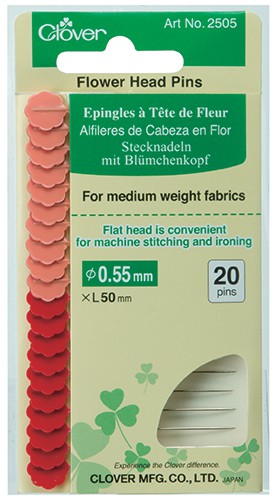

(0.55 x 50 mm)
Regular (Art. No 2506)– Same acute point but a little stronger and longer shaft for multiple layers of heavier fabrics. Great for quilting.


(0.70 x 54 mm)
------------------------------------------------------------------------------
These little gems are perfect for applying appliqués, trims, beads, or sequins to your project. The sharp, tapered point prevents damage to your fabric. The small 3/4″ size allows detailed work when many pins are required and space is limited.
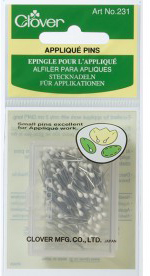

(0.60 x 20 mm)
------------------------------------------------------------------------------
Quilting pins have a fine point and a smooth shaft to make them fabric friendly. They are longer than many straight pins so they can penetrate several layers of fabric and stay in place. Clover quilting needles are available in two shaft sizes, fine for more delicate fabrics and regular for heavier fabrics. They have glass heads so they can be ironed.
Regular (Art. No 2508)
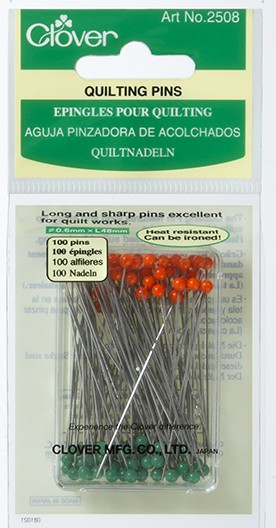

(0.60 x 48 mm)
Fine (Art. No 2509)


(0.50 x 48 mm)
------------------------------------------------------------------------------
Patchwork pins have very fine points for use on the most delicate fabrics like silks and satins. Two sizes are available, fine and extra fine. They have glass heads so they can be ironed.
Fine (Art. No 232)


(0.50 x 36 mm)
Extra Fine (Art. No 2507)
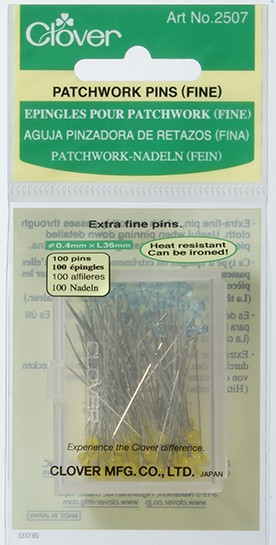

(0.40 x 36 mm)
------------------------------------------------------------------------------
Marbled Glass Head Pins (Art. No 2511)
Marbled Glass Head Pins are a little shorter and finer than the quilting pins. Sharp and thin, they are ideally suited for dress making applications where fine fabrics are being used. They have glass heads so they are iron safe.
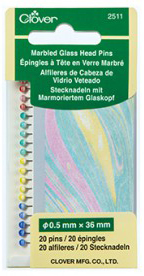

(0.50 x 36 mm)
------------------------------------------------------------------------------
Fork pins have two shafts connected by a turned up end. This allows you to pin fabrics without lifting them. Perfect for securing hard to handle or slippery lining materials. They are great for positioning stripe or plaid fabric pattern alignment prior to sewing in place. They’ve also found a new home in creative contemporary quilting where matching unique shapes is required. Blocking knitted garments? No problem. Clover also has a Fork Blocking Pin that is one size larger and works great with knitted or crocheted fabrics.
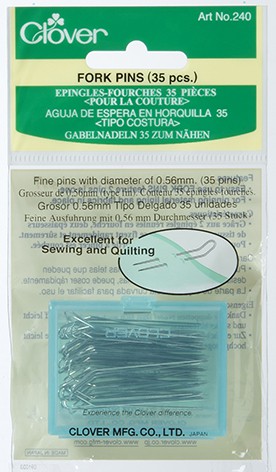

(0.56 mm diameter)
By Steve Butler
Back


